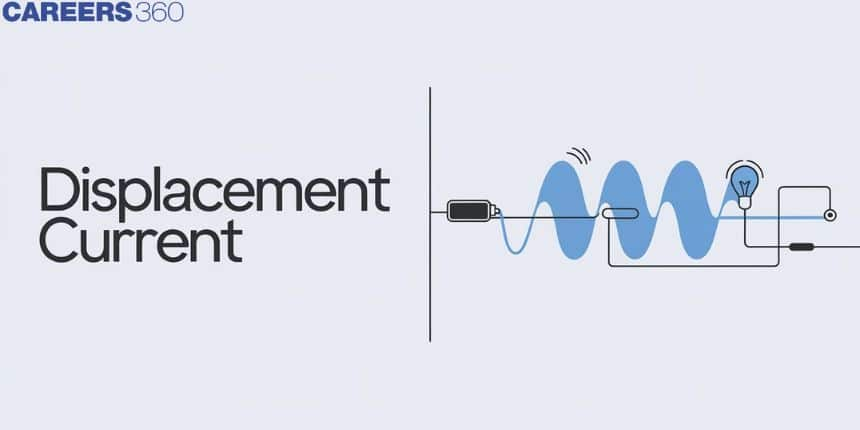Displacement Current - Definition, Formula, FAQs
To understand how the magnetic fields can form in regions without real moving charges, such as displacement current in capacitors. First, you have to understand the concept of displacement current. A capacitor changing charges, or on discharging, produces an effect similar to a current, known as the displacement current. This idea is introduced by James Clerk Maxwell, by extending Ampère's Law to consider both real currents and changing Electric Field, making it a base for understanding electromagnetic interactions.
This Story also Contains
- What is Displacement Current?
- The Maxwell Ampere law-
- The Problem with Ampère’s Law in Certain Situations

What is Displacement Current?
A displacement current is a current that occurs when an electric field changes in time, for example in a capacitor that is charging or discharging. It doesn’t actually involve any flow of charges at all, but it causes an electromagnetic field to change smoothly, like a current. This concept has an explanation for how electric and magnetic fields interact when there are no moving charges.
Mathematically, it is represented as,
$$
I_d=\epsilon_0 \frac{d \Phi_E}{d t}
$$ This equation is also called the displacement current equation.
where:
- $I_d$ is the displacement current,
- $\epsilon_0$ is the permittivity of free space,
- $\frac{d \Phi_E}{d t}$ is the rate of change of electric flux.
Also read -
- NCERT Notes For All Subjects
- NCERT Solutions for All Subjects
- NCERT Exemplar Solutions for All Subjects
The Maxwell Ampere law-
Maxwell’s Ampère Law defines how a magnetic field is created by an electric current or a changing electric field. It is an extension of Ampère’s original law, which only considered constant electric currents.
Key Ideas:
1. Original Ampère's Law: This law states that a steady electric current (like the current in a wire) produces a magnetic field around it. Mathematically, it says that the circulation of the magnetic field $\vec{H}$ around a closed loop is proportional to the electric current $\vec{J}$ passing through that loop.
2. Maxwell's Extension: Maxwell realized that Ampère's Law didn't account for changing electric fields, such as those in a capacitor when it charges. He added the concept of displacement current, which is not a real flow of charges but an effect created by a changing electric field. This "displacement current" creates a magnetic field just like a real current does.
3. Final Form: Maxwell's Ampère Law with displacement current states that the magnetic field around a closed loop is produced by both the conduction current $\vec{J}$ (real current in a wire) and the displacement current $\epsilon \frac{\partial \vec{E}}{\partial t}$ (changing electric field).
The equation of Ampere Maxwell is:
In the Ampère-Maxwell law, the magnetic field $\vec{B}$ around a closed loop is related to the current passing through that loop. The law is expressed as:
$$
\oint \vec{B} \cdot d \vec{s}=\mu_0 I
$$
where:
- $\oint \vec{B} \cdot d \vec{s}$ represents the line integral of the magnetic field $\vec{B}$ around a closed path,
- $\mu_0$ is the permeability of free space (a constant that measures how much the magnetic field can penetrate free space),
- $I$ is the electric current enclosed by the loop.
The Problem with Ampère’s Law in Certain Situations
Ampère’s Law works well for steady (unchanging) currents, but it has a limitation when applied to circuits with changing electric fields, such as those with a condenser (capacitor).
Example with a Capacitor (Condenser)
Consider a capacitor connected to a voltage source, with:
- One plate is connected to a positive charge $Q^{+}$,
- The other plate is connected to a negative charge $Q^{-}$
As the capacitor gets charged, an electric current will flow in the circuit, but no current actually flows between the plates of the capacitor because they are separated by an insulating gap. If we try to apply Ampère’s Law in this case to a loop between the capacitor plates, we run into a problem because we do not have any current there.
Frequently Asked Questions (FAQs)
Yes, along the closed path, the amount of travel and travel current is constant.
Null
Under Faraday's electromagnetic induction legislation, an emf is induced by a fluctuating magnetic field, According to Maxwell, a current and therefore a magnetic field is created in an electric field. Such a current is called the current of displacement. A time-changing electric field therefore produces a magnetic field and vice versa. The electrical and magnetic field behaviour is hence symmetrical.
Ampere is the SI current shifting unit (A)
Null.
The current is called displacement current due to the changing electric field.